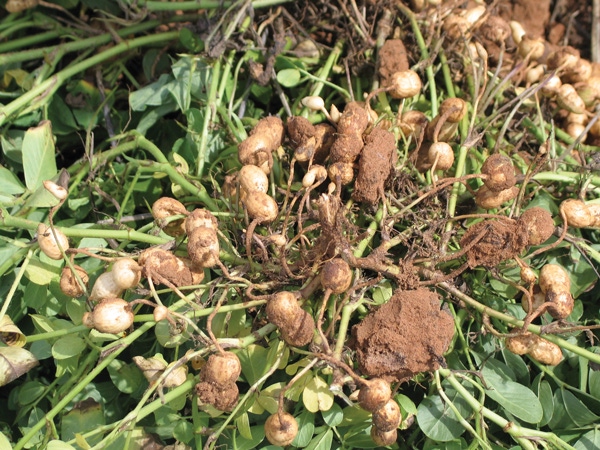
Last year was an unusual one for gathering information on peanut diseases, says an Oklahoma State University Extension plant pathologist.
“We usually get good information on Sclerotinia blight from our trials,” says John Damicone. “Last year, we got nothing.”
Pod rot, on the other hand, was severe, which offered an opportunity to collect good data. “It was the most uniformly severe pod rot infestation I’ve ever seen,” Damicone said during the recent Oklahoma Peanut Expo at the Quartz Mountain Resort near Lone Wolf.
“Too many growers saw pod rot last year,” Damicone said, “mostly on Virginia-type peanuts.”
He looked at fungicides, calcium fertility, and variety selection as possible management options for pod rot.
Fungicides included Abound, Ridomil and ProPhyt (phosphorous acid). Fungicide applications resulted in a significant yield response. Damicone said in one test Abound treatments made 4,000 pounds per acre versus the check plot with a 3,500 pound per acre yield.
He said calcium rate was not a factor. “The disease outbreak did not occur because of a calcium deficiency. Some pod rot fields tested high in calcium.”
Spanish and runner varieties had less pod rot than Virginias.
“In runner peanut trials we expected Flavor Runner 458 to perform worse than it did,” he said. “Pod rot levels on Tamrun OL02 and Tamrun OL07 was low.”
Virginias were hit harder. “We used to see less pod rot on Jupiter compared to other Virginia varieties, but not in 2010,” Damicone said.
He said weather conditions likely prompted the heavy incidence of pod rot. “We had above normal temperatures in June, rain in July and hot and dry conditions in August and September.”
Fungicide trials indicated that ProPhyt and ProPhyt plus Abound were the only treatments “that significantly reduced pod rot compared to the untreated check.”
Leaf spot No. 1
He said leaf spot remains the No. 1 foliar peanut disease for Oklahoma producers. Variety, crop rotation and fungicide are management options. “All are important,” Damicone said.
Early leaf spot is more common than late leaf spot but growers sometimes have a mixture of the two. “Late leaf spot is harder to control.”
Damicone said growers may lose as much as 1,200 to 1,300 pounds of yield per acre with heavy leaf spot infestations. Average loss in four studies last year indicated a 500-pound per acre loss. “It pays to control leaf spot. We have to control it for high yields.”
He says growers can control foliar disease effectively with a full-season fungicide program—six sprays per season. “However, reduced fungicide programs that are effective and utilize fewer sprays per season are needed to reduce the cost of peanut production.”
Damicone is looking at various spray programs including a full-season calendar system with 14-day application intervals beginning in late June and continuing through early September. A second strategy used a MESONET Leaf Spot Advisory Program to time sprays. A third strategy begins a calendar spray schedule later in the season.
Damicone said the MESONET weather advisory will give growers a forecast of conditions favorable for leafspot development.
Fungicides that control primarily leaf spots include Bravo, Tilt plus Bravo, Absolute, Stratego, and Headline, along with some experimental products.
The 2010 leaf spot trials varied depending on location. In a rotated field in Beckham County, “disease development was not sufficient to cause measurable defoliation,” Damicone said. “All the fungicide programs reduced leaf spot to low levels. Disease levels were not sufficient to affect yield or crop value.” At the Caddo Research Station leaf spot was severe on Spanish peanuts planted behind peanuts. “Fungicide programs increased yield by an average of 1,000 pounds per acre.� In general, disease control did not differ between fungicide treatments or application schedules,” Damicone said.
He said growers also need a reduced application program for Sclerotinia blight because the main fungicide options, Endura and Omega, are expensive to apply. In 2010 tests “disease pressure was not sufficient to affect yield.”
He said growers should “wait as long as possible” to apply Endura or Omega. He said some new experimental fungicides “look promising” for Sclerotinia.
In variety trials for Sclerotinia blight last year, Damicone said Flavor Runner 458 was the most susceptible and Tamnut OL06 was most resistant in untreated checks. He said there was little difference in disease control between preventive and demand programs or between the fungicides Omega and Endura.
“All fungicide treatments numerically increased yield and crop value compared to the untreated check, but responses were only statistically significant for Flavor Runner 458. On 458, preventive programs, but not demand programs, increased yield and crop value.”
He said crop values were consistently highest for Red River Runner because of grade advantages.
“Because of the unusually low disease pressure, planting a moderately resistant variety without fungicide treatments was among the most profitable strategies in 2010.”
Damicone also recommends fungicide treatments in fields with a history of southern blight and limb rot damage. Folicur, Abound and Provost “have provided good to excellent control of these soilborne diseases, as well as foliar diseases,” he said.
Damicone says growers should consider field history, variety options and rotation when developing disease control strategies.
He credits both the Oklahoma Peanut Commission and the National Peanut Board for research support and lists several findings made possible through those entities. They include:
Under light pressure, several experimental fungicides provided control of Sclerotinia blight that was similar to Omega and Endura.
Red River runner continues to produce the highest crop values (dollars per acre) under pressure from Sclerotinia blight through a combination of high grades and moderate disease resistance.
On Virginia-type peanuts under severe pod rot pressure, fungicides such as Abound and ProPhyt reduced pod rot, increased yield and reduced kernel damage below 2 percent.
Reduced fungicide programs made according to the calendar or the weather-based advisory program continued to provide good leaf spot control.
Several experimental fungicides provided excellent control of early leafspot and/or web blotch.
About the Author(s)
You May Also Like






